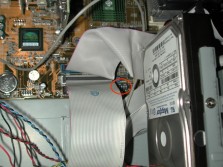Stability
After plugging
in the motherboard and doing a fresh install of Windows Millennium and the
K7VTA drivers, we were met with a flurry of lockups. A quick call to Soyo
produced the VIA 4.04 AGP drivers, which immediately fixed our stability
problems. In our testing we have found that VIA KT133 based boards are generally
not as stable as other chipsets. They are very sensitive to installed hardware
and, overall, have been less stable in our tests. The K7VTA breaks out of
this mold. It is one of the more stable boards we have tested and easily
the best KT133 based board. Seventy two hours of RC5 running in the background
and looping 3D Mark 2000 resulted in only two crashs. Overall stability
is quite good and we experienced few hardware related problems.
Overclocking:
Ever since
the release of the original SlotA Athlons, AMD CPU's have been the choice
of overclockers. Tthe simple reason is that they are not multiplier locked.
As we have seen with other KT133 based boards the EV6 bus and KT133 chipset
are very sensitive to overclocking, leaving the ability to change the multiplier
as the only means for bumping up the megahertz. Offering multipliers of
5 through 12.5X combined with the ability to change the CPU core voltage
from -0.1v through +0.250v in increments of 0.025v is an excellent combination
for great overclocking abilities. In order to stop remarking of its' chips,
AMD has begun cutting the L1 bridges on the surface of the ceramic package.
In order to re-enable multiplier adjustments, all that has to be done is
to reconnect the L1 bridges, as shown below.


In order
to re-enable multiplier adjustments on AMD CPU's, the L1 bridges must be
reconnected. To do this, simply find a #2 HD pencil with a fine point and
draw a line over each set of L1 bridges to reconnect them. This re-enables
the motherboard's ability to change the CPU multiplier.
In testing
we were able to crank up our Duron 700 to 950 before stability was compromised,
and the motherboard was quite ready to go farther. The excellent stability
of the board compliments its' good overclocking options, producing a board
which has above average overclocking abilities. The only hiccup we experienced
while overclocking it was lockups in CounterStrike. The system refused to
run CS in an overclocked state (even 750Mhz), but this instability was not
reproducible in any other application.
The placement
of the multiplier changing DIP switches is our only overclocking complaint
about this board. Placed above the IDE connectors they are nearly impossible
to reach with the board installed. This is ever harder to accept when other
makers are now allowing multiplier adjustments in the BIOS.
